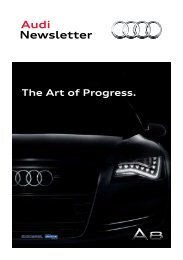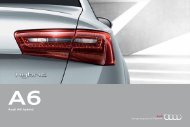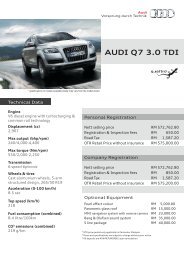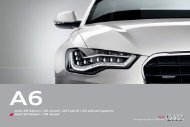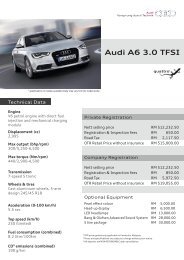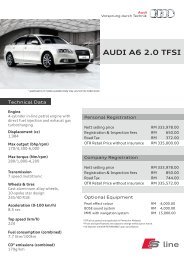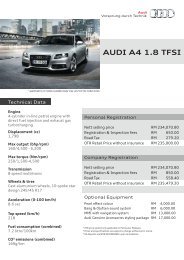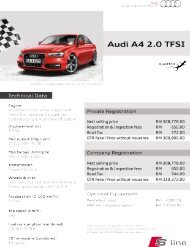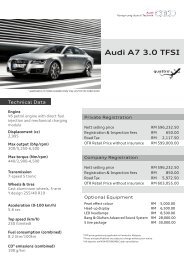drive - Audi
drive - Audi
drive - Audi
Create successful ePaper yourself
Turn your PDF publications into a flip-book with our unique Google optimized e-Paper software.
0102030401 The local <strong>Audi</strong>, Porsche and Volkswagen importer, has amassed all the replacementparts its customers could ever possibly need. And they’ve been doing it since 1953!02 The latest addition to the cadre of cats gets plenty of TLC. He has an important jobhere keeping the mice in check. 03 There was always room for even the bulkiest partssomewhere on the shelves. 04 A lot of work for Timo Schiemer. The old storage space inAsunción, Paraguay, measures several thousand square meters.Could Timo Schiemer be imagined as happy rightnow? Picture him as he toils away in stifling heat under acorrugated metal roof, amid clouds of dust and myriads ofmosquitoes. For days he’s been ransacking cramped rowsof shelves in search of items that were deposited heredecades ago. The setting: a warehouse shed hidden behindanother row of buildings on the Avenida Eusebio Ayala, afaceless arterial road in Asunción, the capital of Paraguay.Timo Schiemer, 32, is a qualified industrial foreman.After working in body manufacturing for the innovative<strong>Audi</strong> A2, he then made a U-turn in 2002 from the ultramodernto the past, which is where he sees his future. Itwas his passion that drove him to take on this formidablechallenge, though the sober title “Coordinator, HistoricSpare Parts Supply” on his business card doesn’t do justiceto his zeal by a long shot. Nobody understands betterthan Schiemer what <strong>Audi</strong> fans want: “When we go to clubevents,” he says, “there’s only one subject of conversation:replacement parts.” And that’s why he is here in Asunción.The street-front has long been lined with moderncommercial buildings, among them the squeaky-cleanshowroom of the local <strong>Audi</strong> importer. The company startedimporting the first Volkswagen Beetles to Paraguay in1953, followed by <strong>Audi</strong> models, and even Porsches havebeen here for quite some time—they sell well in this smallSouth American country. Half a century ago the importerwas already going strong. They owed that not only to therobust nature of the Bugs they imported, but also to theirown forward-looking spare parts strategy: They kept aseemingly never-ending stream of parts rolling in fromGermany just in case, so <strong>drive</strong>rs would be able to get backon the road quickly if they ever had an accident or a breakdown.The plan was to help them avoid exasperatinglylong waits—the average delivery time for replacementparts back then was nine months.The warehouses in Asunción filled up. But as timewent on, a lot less went wrong with the Beetles, <strong>Audi</strong> carsand the like than anyone had figured. The result: As thedecades passed, over 3,500 square meters’ worth of partssimply languished in Asunción, a mammoth depot nobodyhas any use for today. “We even tried slashing prices by upto 90 percent, but it didn’t help much,” says an employee,who maintains a mental map of every single meter of everyshelf. He has been working here since 1972. His currentassignment is to assist Timo Schiemer and two colleaguesfrom Volkswagen Classic, who are spending three days herecombing the wooden shelves and the treasures stowed onthem so long ago. It was no accident that the trio of partsexperts found their way to Asunción, but the result of rigorousresearch. In fact, <strong>Audi</strong> and Volkswagen are currentlybuying up entire repositories of original spare parts on amajor scale, mostly outside Europe. No one in Germany,France or Italy stockpiled such massive inventories.There was no need, what with the high cost of storagespace and the short shipping distances in Europe.But that wasn’t the case in Central and South America,regions where Volkswagen, DKW and <strong>Audi</strong> were strongplayers early on.Several years ago, when <strong>Audi</strong> Tradition startedpaying attention to spare parts for classic and vintagecars, Timo Schiemer and his team had their work cut outfor them. “At the beginning there was hardly anything,”he recalls, “and now we have 20,000 types of items registered.”That number is growing all the time and, accordingto Schiemer’s estimate, around 300,000 parts altogetherare stored in the modern halls of NSU GmbH. That’s the organizationthat takes care of all things that have attaineda certain age, sport four rings and need a replacementpart. “Every day,” Timo Schiemer says, “we log an averageof 30 requests from <strong>Audi</strong> fans.” And the fact that he andhis team are getting better and better at helping them ispartly due to Schiemer’s willingness to travel over 10,000kilometers as the crow flies from his clean, air-conditionedstorage center managed with state-of-the-art logistics, tothis stifling shed in South America to rummage throughthe dust-coated arsenal. He continually unearths rarefinds, including hoods and doors, which are so complexto manufacture that reproducing them is prohibitively expensive.It’s discoveries like these that fulfill the surviving<strong>Audi</strong> classics’ need for parts.One glance is often enough to tellTimo Schiemer what he’s found. Amazingly,time has left hardly a mark on the parts.“Our main goal is to keep these cars running,”says Schiemer, his eyes watering and skin coated with afine film of dust. He doesn’t even notice the discomforts,so strong is his explorer’s passion. It’s just like in the ancientlegends that tell of mysterious treasure maps withenchanted paths leading to magnificent riches. Only thistime the treasure hunt is real. All things considered, TimoSchiemer can definitely be described as a happy man. Avery happy man. //<strong>Audi</strong> Tradition parts shopThe <strong>Audi</strong> Tradition Teile Shop (online parts shop) is open 24/7. Customers in Germanyand Austria can place orders directly. For deliveries to other countries, thereis a contact form to fill out and, of course, <strong>Audi</strong> dealers also gladly accept orders.Before a new part is taken out of storage and made available for purchase, it issubject to rigorous examination by experts. It is described in detail and photographed.Safety-relevant components are filtered out. Some of them are used asthe basis for factory reconditioning.Contact the <strong>Audi</strong> Tradition Teile Shop atwww.audi.de/tradition-parts.You can find more images in the<strong>Audi</strong> magazine iPad app.021 / <strong>drive</strong> / <strong>Audi</strong> magazine <strong>Audi</strong> magazine / 022



